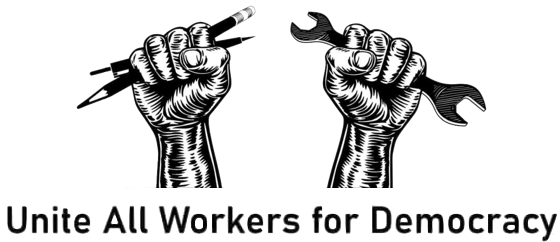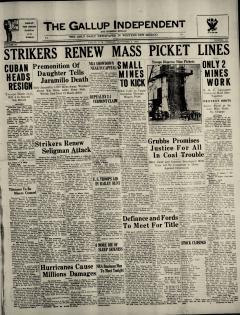Follow Erik Loomis on Twitter
Read Erik Loomis on Lawyers, Guns, & Money
Historian Erik Loomis on This Day in Labor History: August 29, 1933. The National Miners Union shut down mines in Gallup, New Mexico. This pit Mexican and white miners against Navajo miners, which is a good moment to talk about the complexities of race and labor in the West.
In the aftermath of the Navajo Long Walk in 1864 and then the creation of the Navajo Reservation in 1868, the Navajo had a radically transformed economy. Gone were the old ways of raiding. Sheep became increasingly important to the economy and to social status.
But not everyone could survive that way. Wage labor became increasingly important to the Navajo economy after 1900. Reservation border towns or nearby cities became important places for Navajo workers to eke out a living–Flagstaff, Farmington, and Gallup especially.
By the 1930s, Gallup was the most industrialized region of New Mexico. This hardly meant it was Pennsylvania. But it was a leading coal center for the Southwest — second only to the southern Colorado coalfields famous in labor history for the Ludlow Massacre.
Up to around 1930, Navajos didn’t make up that large a percentage of the Gallup industrial workforce. Immigrants from Mexico and Europe were far more common.
Most Navajo coal miners either operated small mines of their own or worked with the Bureau of Indian Affairs on a few government operated mines on the reservation. If they mined on their own land, they could basically control the process and the work.
But when they left for Gallup, they entered into the world of racial segregation that replicated itself in labor segmentation, meaning they would be placed into the worst and most dangerous jobs.
There was a small but growing labor movement in New Mexico at this time, centered around the mines in Gallup and in Madrid, which is between Albuquerque and Santa Fe (and which has a lot of cool old mining detritus all over the place if you ever get the chance to visit).
The Mexican miners — who brought the radicalism of the Mexican Revolution with them — led this effort. For them, the United Mine Workers of America was not nearly radical enough.
They preferred the National Miners Union, the communist union that was set up to challenge the UMWA. There was plenty of reason for these workers to be angry. Conditions in the mines were pretty bad.
Wage cuts, racial discrimination, payment in company scrip instead of cash, workers being forced to do so-called “dead work”–things such as putting up mine timbers so the roof didn’t collapse on them–without pay: these were all good reasons to join the union.
On August 29, the miners went on strike. The workers had a lot of enemies. The UMWA was furious that their rival went on strike.
New Mexico governor Arthur Seligmann used the power of the state to tip the scales for the mine owners, deputizing the National Guard to prevent groups larger than five people from congregating near the mines, effectively making picketing illegal.
And the Navajos would have nothing to do with them. In fact, the Navajos frequently crossed the picket lines.
NMU leaders wrote to Seligmann to stress that the Navajos were being taken advantage of and that they were working in dangerous conditions, claiming they were “improperly equipped according to state mining laws.”
Seligmann did have the National Guard investigate, whatever that really meant. They of course declared it was all fine.
However, some of the discomfort with the Navajo miners was about supposed benefits they had versus non-Indian miners.
A striking miner named Stuart Hines wrote: “The Indians live in hogans and of course pay no rent and receive all the benefits the Government extends to all other members of the tribe. This is most unfair competition to white miners who have spent their lives in the coal mines.”
This line of argument–that Indians have it so great compared to whites is totally bonkers to anyone who knows even the slightest bit about American history or contemporary race relations and that wasn’t different in 1933.
Not to trivialize the hard lives of white miners, but this kind of racial resentment drives straight to the heart of the key problem of American labor history: divisions by race.
On the other hand, the Navajos most likely did not consider themselves or their lives particularly similar to other miners. They were going into the mines out of economic necessity like everyone else, but they definitely kept one foot back on the reservation.
This was not a proletarian workforce. And yet, when the NMU posted the wage rates for Indians compared to others, it really did outrage everyone else and it’s hard to blame them for that. Pay rates for Native workers were very low, much lower than for others.
On November 22, the NMU declared victory and it was real enough. They forced the mine owners to increase wages, eliminate the company scrip, and rehire fired unionists. No, they did not win recognition, the hardest thing of all to win.
But the companies did not keep their promises and tensions rose through 1934. By this time the miners were often getting relief from the Federal Emergency Relief Administration. The NMU organized these projects too.
When the FERA cut wages on a public works project, the NMU struck as well. That strike turned violent.
The American Legion and Veterans of Foreign Wars — white supremacist and proto-fascist organizations that frequently engaged in violent anti-labor actions in these years — led the fight in Gallup to stop paying relief to the Mexican miners.
When a NMU organizer was arrested for leading an anti-eviction action, someone shot up the courthouse and killed the sheriff. This led to the mass deportation of the Mexican miners. Meanwhile, the Navajo miners were staying far, far away from any of this.
As the strike became more connected to the rights of Mexican miners, the Navajo had very little interest and — with already bad relations to the union leaders — they were peripheral to the later action.
The NMU collapsed in the aftermath of the deportation. The UMWA stepped in and finally won a contract when the government basically forced industry to accept union contracts in 1943. At that point, a few Navajos were union members.
But most sought short-term jobs that would allow them to avoid the unions they felt were outside institutions that did not welcome nor understand Navajo culture.
I borrowed from Colleen O’Neill’s, Working the Navajo Way: Labor and Culture in the Twentieth Century, to write this thread. It’s an excellent book, a pioneering labor history of Native America.
I will close by saying that if your understanding of race in America doesn’t include the American West, you are really missing out on the complexities of how race operates in America in some fascinating and critically important ways.

